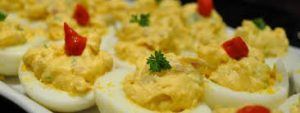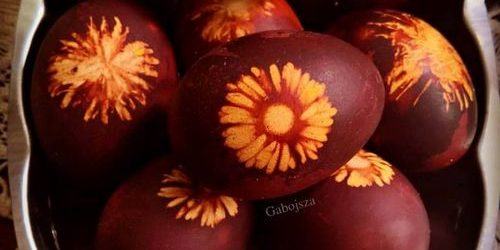When my children were young, I spent days with them decorating our home for Easter. Rabbits and eggs were everywhere. Rabbits could come only in the form drawings and puppets because we lived in an apartment but the eggs had to be real. I spent years trying out different natural dying substances for the eggs, because synthetic colourants– naturally – were out of the question. I also experimented with the eggs themselves: cook and colour them or empty them before decorating them. How to empty the content of an egg? Make holes at both end of the egg and blow the raw content from one end of the egg through the other end. Good way to get a headache (from the hard blowing), but at the end of the day you can make a big pile of scrambled eggs or cakes and if your children did not break all the eggshells, you ’ll have enough empty whole eggs to experiment with the numerous ways of decorating them.
But, what do eggs have to do with Easter? The egg is a symbol of fertility and the start of a new life, and as such, it is closely related to spring and the idea of renewal and resurrection. Some say the painted egg’s red colour symbolizes Christ’s martyrdom, however, the tradition of egg-painting goes back to pre-Christian times.
Traditionally godparents gave painted eggs to their godchildren at Easter and girls would give eggs to the boys who sprinkled them with water on Easter Monday. Eggs were coloured with natural paints. Redwood, saw-wort was used to attain different shades of red and safflower and crabapple tree bark was used for yellow colouring. Onion, however, was the most widely used colourant everywhere. The outer protective layers of the onion produces dark red-brown colour on the egg’s surface.
If you want to add red shade to your eggshell, you may try red paprika powder this Easter to colour your eggs. Add 4 to 6 teaspoons of red paprika powder to a smaller pot of water, boil it for 20 to 25 minutes and you get a nice colouring liquid. The colours will go from orange to light red. This same liquid may be used with the overlay technique: press decorative plant leaves onto the eggs (use a stocking for this purpose for example) and let the eggs sit in the colouring liquid for time to produce a nice result.
Now, if you’d rather use the paprika powder for eating than decorating, then add spicy paprika powder for your cooked egg-halves. That’s deviled eggs. Here’s the recipe:
Peel and cut boiled eggs into halves. Scoop out the yolk from all of them and mix the egg yolk with sour cream, mayonnaise or mustard, onion, ground nutmeg, salt and pepper. Fill the egg whites with this creamy yellow egg-mixture and add red colour on top to make them look devilish: red pepper cubes, red paprika powder (the spicier the more devilish) or red paprika cream.

Deviled eggs for Easter
Tetszett a cikk? Ha szeretne még paprikás és fűszeres témában, heti rendszerességgel cikket olvasni, hírt kapni az ÚJ paprika elkészültéről, iratkozzon fel hírlevelünkre. Subscribe to our Blog and enjoy our Paprika Poster.







